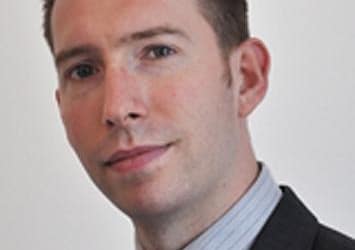
Kames Capital investment manager sees positive economic scenario
Summarising the investment strategy for the Kames Capital Global High Yield Bond Fund, Edinburgh-based Stephen Baines (pictured above), Investment Manager, Fixed Income, said the fund is currently overweight in single B bonds and underweight in triple C bonds, with a bigger tilt towards the United States bond market.
Mr Baines was briefing local financial intermediaries earlier this month during a two-day visit in which he also held several meetings with the local financial services community.
The improving trends that have been witnessed in the global economy since the end of 2012 have had a positive impact on credit. “Companies have been provided with growing revenues, growing profits and steady cashflows. These trends allow them to, if they wish, pay down debt. It gives management teams options of what to do with how to run their businesses,” Mr Baines said.
This scenario, coupled with record low interest rates, has brought defaults to an almost record low level, he pointed out. Easy monetary policies in all the major economies have enabled companies to borrow for longer maturities, pushing back refinancing needs.
“They have also been able to refinance at much lower interest rates and this has allowed companies to reduce their financial commitments and, combined with growing profits, should lead to much better cashflow situations for many businesses. This should be attractive for companies in the high yield space that are particularly sensitive to economic conditions and to interest rates,” Mr Baines said.
Kames Capital see three major challenges in the current scenario. The strengthening economy, combined with low interest rates, has led to yields at record low levels. “As high yield bond managers, we have two choices in this situation: we can accept the slightly lower yields, or we can try to chase the returns we had before by moving up the risk spectrum, so taking higher levels of risk within our funds,” he observed.
The best route for Kames Capital in this situation is to accept slightly reduced yields.
The second challenge is the sovereign fiscal situation within the Eurozone. “We believe banks in Italy, Greece, Portugal (and) Spain are still in a very fragile situation and that any hiccup in the global economy would disproportionately affect companies in these regions. So, we are wary of taking on significant exposure within these areas,” Mr Baines said.
The third challenge – almost a function of the first – is the strong technical conditions in the new issue market as a result of the historic low yields. “Investment banks are launching new issues to the market that are being substantially oversubscribed. There simply aren’t enough new issues to go around to provide sufficient volume for the inflows that many managers are facing in the market,” he pointed out.
This has brought a number of lower quality bond issues to the market, even by companies that were on the verge of default. “We think lending to some of these companies is less attractive, so we are trying to maintain our credit standards in this situation. One of the things we are doing to try to some extent to maintain yields and to maintain quality in the fund at this time is to invest more in the United States High Yield Bond market,” Mr Baines said.
Recovery in the US is better embedded than in Europe, yields are higher, with better credit spreads, and new issues are slightly better quality, comparing like with like.
In terms of positioning, the Kames High Yield Global Bond Fund has a bias towards the telecommunications sector and consumer non-cyclicals, pushing for diversification and best value.
- November 19, 2013 No comments Posted in: Business





